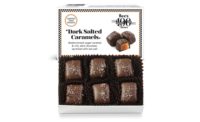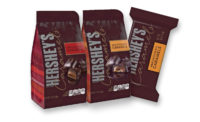There are many different types and styles of caramel and just as many visions of what is the “best” caramel.
Some applications require a soft, smooth and flowy caramel, while others need a flavorful caramel with a firm texture. For others, being the most economical is the ‘best’ caramel. Having a caramel that works with your equipment/processes and meets or exceeds your customers’ expectation is the ‘best’ caramel.
Caramel is generally affected by time, temperature (process) and formulation. Flavor, color, texture and water activity (Aw) are the attributes we adjust in our formulations and processes to give the desired caramel. Flavor and color go hand-in-hand (i.e. more color results in more flavor), and they are the result of caramelization.
Most caramels are created by the Maillard reaction where reducing sugars (such as glucose, fructose and lactose) and amino acids (generally from milk products) in the presence of heat will give us the familiar flavors and colors we all enjoy.
Sugar can also be melted and caramelized to give us a caramel color and flavor. This caramel is usually found in the culinary world and provides a flavor different from Maillard reaction caramel. The process of caramelizing sugar lends itself to smaller artisan operations rather than larger quantities. For the purpose of this article, we will focus on Maillard caramels.
To achieve more flavor and color by formulation, we can do some of the following:
- Increase reducing sugar levels by using higher levels of ingredients such as dairy and syrups – especially invert sugar and high fructose corn syrup.
- Increase protein levels by adding more dairy components.
- Use butter or milk fat instead of refined vegetable oils. Flavor notes are also lost when high melting point fats (above 100ºF) are used.
- Using salt, vanilla and replacing some of the white sugar with brown sugar/molasses
To achieve more flavor and color by processing, try the following:
- Increase cooking/caramelization time.
- Minimize vacuum cooking.
- Add as much of the milk ingredients as possible at the beginning of the cook.
Water activity is seldom a concern with most caramels unless they are soft caramel fillings and sauces. When the Aw of caramels is above 0.68, there can be a potential for yeast and mold growth unless a preservative is used.
To produce a soft-texture, stable caramel with a lower water activity, the following will help:
- Use more syrups than sugars.
- Replace lower DE syrups with higher DE or invert syrups.
- Reduce protein levels and/or replace milk solids with whey solids.
- Use lower melt point fats and increase the total amount of fat.
Texture is one of the more complicated challenges in making caramel. Often solving one problem (such a reducing cold flow) will cause another (texture is too hard). Texture concerns include stickiness, toughness/softness, standup and grainy/ungrained.
Stickiness in caramel can be a blessing or a curse. It is useful for making caramel nut clusters when it causes the caramel and nuts to adhere to each other, but not always appreciated when the caramel sticks to your teeth. To reduce stickiness in caramel, the following points should help:
- More fat = less stickiness – start with at least 10 percent in formula
- Increase the ratio of sugar to syrups
- Use lower DE syrups and decrease the amount of reducing sugars/sugar inversion
- Add mono & diglycerides (about 1 – 1.25 percent)
- Higher cook temperature/lower moisture content
Toughness in texture is often found when trying to reduce cold flow in caramel. To minimize caramel with a tough texture, you can use higher DE syrups and increase the ratio of sugar to syrups.
Stand-up quality (opposite of cold flow) is desired when we want to maintain the shape when dipping or cutting caramel. Nothing is more frustrating than seeing a pool of caramel at the base of your recently-dipped apples. The difficulty is making a caramel that has standup without being hard. Do not despair – there are solutions which include:
- Colder storage conditions
- Increase amount of dairy proteins
- Use a fat with higher melt point
- Intentionally grain the caramel
- Reduce amount of syrups/sugar inversion and increase sugars
- Increase cook temperature/reduce moisture
There are two types of graininess in caramel: protein grain and sugar. Sugar grain is hard crystals that will dissolve in water, while protein grain is soft textured “globs.” Protein grain (denaturation) usually occurs when there are acidic conditions and causes the proteins to curdle. It can also happen when there is excessive moisture in the caramel premix, and that is the reason we drip-feed evaporated milk during cooking while maintaining a boil. Minimize protein grain in caramel by:
- Insuring all milk powders (if used) are properly hydrated
- Making sure that the caramel premix is not acidic. If needed add disodium phosphate, sodium citrate, ammonium carbonate or bicarbonate of soda to protect the dairy proteins
- Avoid excessive moisture in caramel premix. Moisture range of 20 – 30 percent is acceptable. Add reserved milk solution when a cook temperature of about 228ºF is reached. Gradually add milk while maintaining a boil.
Sugar grain will often occur in caramels upon storage and develops more readily in soft caramels and sauces than in firm caramels. Some caramels are intentionally grained because they will give a softer texture and good standup quality compared to an ungrained caramel. Typically a caramel with more sugar solids than syrup solids is grained by adding 3 – 10 percent of a graining agent (fondant, fondant sugar or confectioners’ sugar) to cooked caramel mass between 170 – 180ºF. Graining can also be induced by using mechanical agitation on cooled caramel.
Formulation and process can both cause unwanted graining in caramel. While most caramels may eventually grain, we only need to have our caramels remain free of graining for the shelf life of the product. Guidelines to prevent graining by formulation include:
- Sugars not dissolved – have minimum of 18 – 20 percent moisture in caramel premix
- Have more syrup solids than sucrose solids
- Less than 17 percent lactose and 30 percent dextrose/fructose
- Maintain 1.3:1 or higher monosaccharides:disaccharides ratio
Look at the following items if you wish to prevent graining by process:
- Minimize handling below 170ºF after caramel is cooked. Be especially concerned about high-speed rotary pumps and cook kettle agitation.
- Cool caramels in a timely manner. Do not pack hot into corrugated boxes.
- Less graining is seen in cooler storage conditions
- Cooking the caramel mass below the scrapers or steam jacket level and causing dry scraping
- Addition of scrap during cooking that contains undissolved sugar crystals
There are many factors involved in the equation of making the “best” caramel. Determining the key desired attributes is the first step in achieving this. Using ingredients with consistent quality in a consistent processing manner will allow you to be known for making the “best” caramel.







